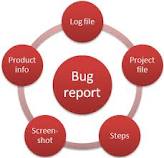Developers consider testers as troublemakers. This is because they are in software testing industry and their prime focus is to test the product and report issues. Nevertheless, the main aim of testers is to deliver a quality product to the client.

Besides the core job of producing high quality code, every developer should also strive to be complete in his/her job in providing sufficient release notes to the rest of the team on what code fixes have gone into each build. The same is very important for a tester, where besides just testing the product and finding bugs, he/she should effectively communicate them to the rest of the team through comprehensive bug reports. A lot of time is often wasted by both the development and QA testing teams in resolving defects that are poorly reported without complete information. How well and correctly we report a bug goes a long way in building a tester’s reputation in the product team If a developer is not able to understand the bug at the first glance, the probability of it getting fixed goes down.
More often than not, developers:
-Require more information in the bug report provided by testers
-Reject the bug saying it is “not reproducible”
To reduce such scenarios, help save time for everyone and also represent the test team well, testers need to spend more time in ensuring the quality of bug reports. Most of theOutsourced Software Testing Companies understand the importance of effective bug reporting. It is said that finding a bug is only 50% of the task; effective bug reporting is equally, or even more important, in getting a particular issue resolved.
Effective Bug Reporting:
A bug report is said to be effective if it is precise, unambiguous and the developers get to know at first glance where the problem lies. Following are the characteristics of an effective bug report which is followed by Outsourced Software Testing Companies:
- Unique Bug ID: Always assign a unique number for identification of the bug. Typically, the defect management system will automatically generate this
- Bug Summary: The summary is the developer’s first interaction with your bug report; hence, it should be precise & clear. Writing a one-line report summary (bug’s report title) is an art and comes with practice. A tester must be a master of it. The secret of writing an effective headline is that it should be clear and accurate
- Environmental Detail: Environmental details include information of all OS/Browser combinations on which test was performed, build number and any other software and hardware configurations the developer needs to be aware of
- Priority/Severity: Priority of the bug describes the impact to business and it changes as per the business circumstances. Severity of the bug describes the impact to users. The bug should be assigned the correct priority and severity. A tester has to get into the user’s shoes to understand this in depth. The higher the priority, the higher the chance of fixing it. Similar is the case with severity. These two are typically revisited when the product team gets together to triage the bugs before it is assigned for a fix
- Steps to Reproduce: Analyze the problem to report it in minimum number of steps. Steps to reproduce should be concise and clear
- Actual Result: This describes the actual behavior of the application on executing the steps to reproduce
- Expected Result: This describes the expected behavior of the application as per the stakeholder requirements
- Screen shot/ Videos: We must attach screen shots or videos for the proof of the bug and also for the developer to understand it. They are of utmost importance for intermittent issues. Any log files, system trace files should also be provided whenever possible
- Reference: We must provide test case ID, requirement ID, and spec references to help developers better understand and to enable them to map the defect into the product plan. It also saves time for the entire team in placing the issues and deciding whether or not to fix it in the current release
- Others: Other details such as “how the issue was found”, “whether or not it is a regression”, any other relevant notes to the developer, any other linking to existing similar bugs should also be added to provide as much detail as possible helping the developer not just see the problem but easily identify the root cause
While the above defined points, outline the general best practices in defect reporting, the test team should also closely work with its product team to define protocols that work the best for the team. Each team has its own working practices, so it is best to customize the report to align with the team’s needs to make everyone’s job easier.
As the bug report is the major or sometimes the only communication between various teams involved in the project, it should be prepared with utmost care. It is a report that is a handy reference not just in the current release but also sometimes for several more releases to come. Therefore, a tester must focus on writing a good bug report. Efforts of a Software QA Testing engineer towards writing effective bug reports will save company resources and also create a good relationship amongst the entire product team.

This is Rohan, I’m a Digital marketing Expert, Full time Content Writer and founder of BoxerTechnology.com I can help people across the world through my articles. I am sharing the latest stories from companies like Apple, Samsung, Google, and Amazon.




Leave a Reply